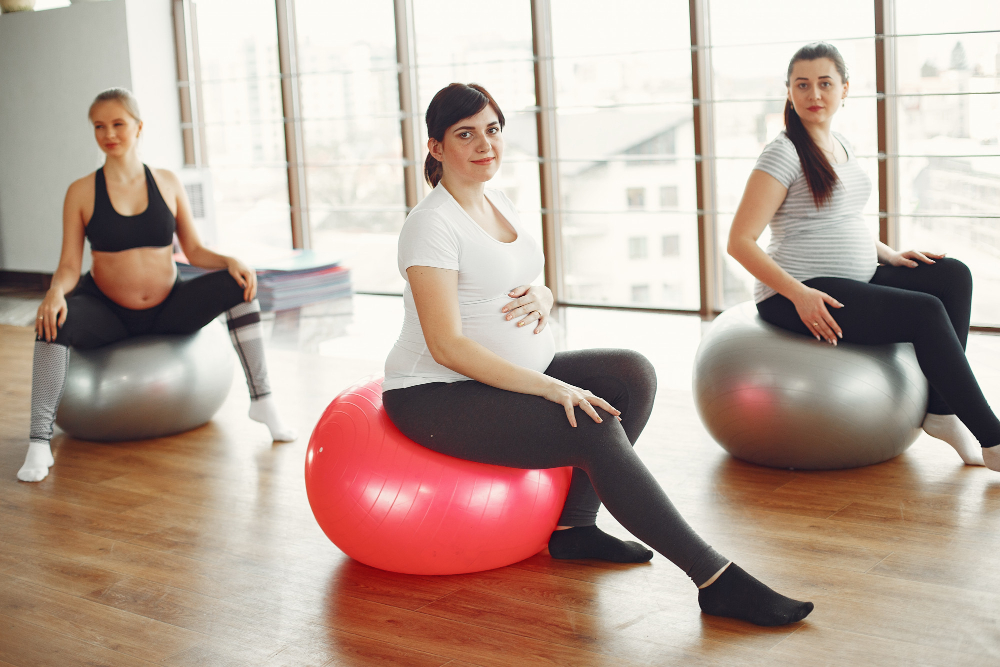Pelvic pain during pregnancy can feel like a cruel joke. Your hips feel like they’re splitting in half when you walk, roll over in bed, or just try to stand up. It’s frustrating, exhausting, and way too common.
You might be wondering if there’s anything you can actually do about it, besides waiting it out or popping a pillow between your knees at night and hoping for the best.
That’s exactly where this guide comes in. In this post, we’re breaking down exercises for pelvic pain during pregnancy that are actually safe, doable, and worth your time. We’ll cover:
- Why pelvic pain happens in the first place.
- How gentle movement and the right kind of exercise can help.
- The best stretches for instant relief.
- Targeted strengthening moves that support your pelvis, hips, and lower back.
- And small daily habit tweaks that can make a big difference in how you feel.
Read This Before You Start with Exercises for Pelvic Pain During Pregnancy
Staying active during pregnancy is one of the best things you can do for your body. But just because exercise is encouraged doesn’t mean you should go with full force.
Start by checking in with your OB or midwife. Every pregnancy is different. Some exercises might be totally fine for one person but off-limits for another.
If you’re dealing with any bleeding, dizziness, severe pain, contractions, leaking fluid, or high blood pressure, you should stop what you’re doing and talk to your provider.
Know Your Pain Scale
You should feel something during a workout. It’s okay to feel a light challenge, put in a bit of effort, and maybe even experience some muscle fatigue. But pain? That’s a red flag.
Use this rule: aim for pain no higher than 3 out of 10 while you’re moving, and it shouldn’t feel worse 24 hours later. If something hurts more afterward or spikes during the movement, that exercise needs to go.
General Guidelines for Safe Exercising During Pregnancy
Move with control.
Now’s not the time for jerky motions or deep, aggressive stretches. Keep it slow, intentional, and within your comfortable range.
Be mindful of lying flat.
After around 20 weeks, skip long periods lying flat on your back. The weight of your uterus can press on a major vein (the vena cava), which can lower blood flow and leave you dizzy or lightheaded. Go for a side-lying position or use an incline of 30 to 45 degrees instead.
Exhale on effort.
Exhale during the hardest part of the movement. This helps manage pressure in your core and keeps your pelvic floor protected. Don’t hold your breath.
What Do You Need to Know About Pelvic Pain During Pregnancy?
Pelvic pain during pregnancy is common, but that doesn’t make it any less frustrating. It shows up in different ways and for different reasons. In general, pelvic pain in pregnancy falls into three main patterns.
SPD (Symphysis Pubis Discomfort): Sharp and stabbing pain right at the front of your pelvis (the pubic bone). It can happen when you go to lift one leg, step out of the car, or walk up the stairs. SPD tends to flare up with single-leg movements, especially when your legs are doing different things.
Posterior Pelvic Girdle or SI Joint Pain: Shows up more in the buttocks or lower back, usually on one side. It can be dull and nagging, or sharp when you’re doing something like rolling over in bed, standing for too long, or taking a long walk.
Hip and Soft-Tissue Contributors: Sometimes, the pain isn’t coming from the joints directly, but from the muscles and tissues around them. Tight hip flexors, weak glutes, and deep core instability all change how your body moves.
The right exercises can be one of your best tools for managing pelvic pain. By engaging in specific workouts, you could reduce muscle guarding (where your body tightens up to “protect” the area), improve how your pelvis handles load, and keep everything moving in better alignment.
What Will You Need for Pelvic Exercises During Pregnancy?
Here are a few basic items that can make your workouts more comfortable and effective.
- Yoga mat, pillows, or a folded towel for support and cushioning.
- Light mini-band and a long loop band for resistance work.
- Small ball or pillow for inner thigh squeezes.
- Sturdy chair or access to a clear wall for balance and support.
Optional but helpful:
- Maternity support belt.
- Foam roller.
Foundations and Simple Exercises – Breathing and Core Connection
When it comes to pelvic pain, how you breathe and connect with your core can make a huge difference.
These are the kinds of exercises you can do anywhere, anytime. Sitting on the couch, standing in the kitchen, lying in bed. A few times a day is enough to start feeling a difference.
360° Diaphragmatic Breathing
- Inhale slowly through your nose, letting the air expand into your ribcage, sides, and back. Let your belly gently rise without forcing it.
- Exhale through pursed lips. As you breathe out, lightly engage your pelvic floor and deep abdominal muscles. Not a big squeeze, just a subtle lift and pull-in.
Pelvic Floor Coordination
- Inhale: Let your pelvic floor relax and lengthen. Think “soft” or “open.”
- Exhale: Gently lift the pelvic floor for support. Aim for a small, controlled contraction, not a hard Kegel.
Transverse Abdominis (TA) Activation
- On the exhale, imagine zipping up from your pubic bone to your belly button. Keep the effort light (just a 2 or 3 out of 10). You should still be able to breathe.
Best Exercises for Pelvic Pain During Pregnancy and Routine Examples
Here are the 2 workout routines that you can use based on your current fitness level.
A) 10-Minute Pain-Relief Stretch Flow
Feeling tight, achy, or just need a reset? This flow helps ease tension.
- Child’s Pose with Wide Knees – 60-90 sec: Rest your chest on a pillow and let your belly drop between your legs for more comfort.
- Cat-Cow – 8-12 slow reps: Flow gently through spinal flexion and extension. No speed, just control.
- Hip Flexor Stretch (Half-Kneeling) – 30-45 sec each: Tuck your pelvis under and keep it small. You should feel a light stretch, not a deep pull.
- Figure-4 Glute Stretch (Reclined) – 45-60 sec each: Use a strap or towel behind your thigh if needed. Avoid straining your upper body.
- Adductor Rock-Backs (Quadruped) – 8-10 each side: Keep the movement small and supported. Focus on control, not depth.
20-Minute Stability & Strength Circuit
This routine builds control and strength where you need it most: your core, glutes, and hips. Aim for an RPE (rate of perceived effort) of 4-6 out of 10.
Block 1: Stability
Repeat twice.
- Pelvic Tilts (on ball or against wall) 10-12 reps.
- TA Heel Slides (Supine or Inclined) 8-10 each side.
- Side-Lying Clams (with Mini-Band) 10-12 each side.
Block 2: Strength
Repeat twice.
- Glute Bridge with Ball Squeeze 8-12 reps
- Chair Sit-to-Stand 8-10 reps
- Standing Pallof Press (with Resistance Band) 8-10 each side
Rest 30-60 seconds between exercises or rounds.
Need more ideas? Here are additional exercises that you can do if you notice something doesn’t work for you, or feel too hard.
Additional Stretching Exercises for Relief
Some days, you just need a little extra release. These stretches are gentle, targeted, and easy to fit into your day.
Thoracic Opener at the Wall
-
- Great for: posture, back tightness, breathing
- Stand facing a wall, place your hands shoulder-height, and gently press your hips back to open through your mid-back and chest. Keep knees soft and breathe into your ribs.
Hip Flexor Stretch (Half-Kneeling)
-
- Great for: relieving front-hip tension
- Set up in a half-kneeling position. Tuck your pelvis under first (like you’re zipping up tight jeans), then shift forward slightly. Keep the stretch small — no lunging or collapsing into your low back.
Piriformis/Glute Stretch
-
- Great for: deep glute and pelvic relief
- Option 1: Reclined figure-4 (lying on back with ankle over opposite thigh).
- Option 2: Seated figure-4 with support behind you.
- Use a strap if you can’t comfortably reach your leg. Focus on breath and release.
Hamstring Strap Stretch
-
- Great for: lower back and leg tension
- Lie on your back with one leg up, knee slightly bent. Loop a strap or towel around your foot and gently pull the leg toward you..
Wall Calf Stretch
-
- Great for: easing walking pain and tight lower legs
- Stand facing a wall, place your hands for balance, and step one foot back. Keep your back heel down and gently press your hips forward until you feel the stretch in your calf.
Trimester-by-Trimester Adjustments
As your body changes through different trimesters, you should also adjust the exercises.
First Trimester
This is the time to lay the foundation. You might still feel like yourself, but that’s a perfect time to establish good habits.
- Focus on 360° breathing and core connection.
- Introduce light strength work 2-3 times per week.
- Keep sessions short, manageable, and form-focused.
Second Trimester
Energy often picks up here, but your belly starts growing, balance shifts, and posture gets tested. It’s time to adjust positioning and reduce intensity.
- Avoid lying flat for long, instead elevate your head or switch to side-lying.
- Shift more movements to standing or supported positions.
- Be gentle with stretching and avoid deep end-range holds.
Ab exercises strengthen the pelvic floor. Try these ab exercises specially designed for the second trimester.
Third Trimester
By now, it’s all about comfort, function, and support. Your joints are looser, your endurance might dip, and your priorities shift toward preparing for labor.
- Keep sessions short but consistent (10–15 minutes, more frequently).
- Emphasize isometric holds (like gentle squeezes) and supported positions.
- If possible, try water walking or swimming.
Daily Habit Fixes That Could Reduce Pain
These daily habit tweaks don’t take much effort, but they can reduce the strain on your joints, muscles, and pelvic floor.
- Sleep: Lie on your side with a pillow between your knees and ankles to keep your hips neutral. Tuck a small pillow under your belly for extra support.
- Getting Out of Bed: Roll to your side, keep your knees together, and push yourself up with your hands.
- Standing and Walking: Take shorter strides and try not to waddle. Switch arms regularly if you’re carrying bags so one side doesn’t take all the load.
- Stairs: Go slow. Use a step-to pattern (both feet on one step before moving up) on rough days.
- Desk Setup: Your hips should be slightly higher than your knees, feet flat on something solid. Set a timer to move every 30-45 minutes.
- Footwear: Wear supportive shoes with a slight lift and solid arch support.
Final Thoughts
Pelvic pain during pregnancy might be common, but that doesn’t mean you have to suffer through it. With the right stretches, smart strength work, and a few simple habit tweaks, you can feel more stable, more supported, and a lot more like yourself.
FAQ
Is it safe to exercise if I have pelvic pain during pregnancy?
Yes, in most cases. But it can depend on the cause and severity of your pain. Always check with your OB or midwife before starting or continuing any exercise routine.
Can pelvic pain go away with exercise?
In some cases, yes. The right exercises can reduce muscle tension, improve alignment, and support your pelvis better.
What if an exercise makes my pain worse?
Stop immediately. Pain higher than a 3/10 or pain that lingers more than 24 hours is a sign to modify, regress, or skip that movement altogether.
Is walking good for pelvic pain?
Sometimes. For mild pain, short, easy walks can help. But if your pain increases the longer you walk or you start waddling, it may be time to scale back.





